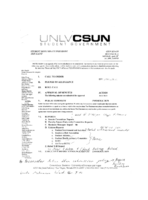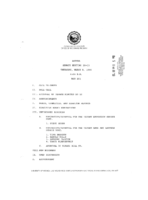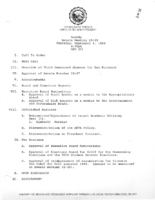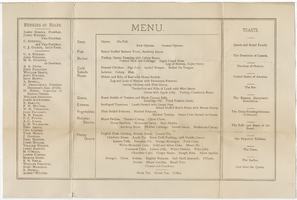Search the Special Collections and Archives Portal
Search Results

Transcript of interview with Elmer Hilsinger by Irene Rostine, October 2, 1991
Date
Archival Collection
Description
When Mr. Elmer Hilsinger arrived from the Los Angeles area in 1942, to work as a Refractory Inspector in the Engineering Department at Basic Magnesium Incorporated (BMI), little did he know the town site would grow to be known as Henderson, Nevadain a few short decades. Mr. Hilsinger’s oral history provides a glimpse of the work being done by women at BMI, including women working as chemists, truck drivers, and secretaries. His words attest to the strong work ethic demonstrated by women at the plant during the “war work” period. Through Mr. Hilsinger’s story, we are also provided with an account of what daily life was like for a married couple, including Mr. Hilsinger’s life with his wife who worked as a waitress at Anderson Camp. In addition, Mr. Hilsinger’s oral history touches on the evolution of safety rules within the plant, the transition from the American Federation of Labor Union to the Congress of Industrial Organizations Union, and the role prostitution played during the tim
Text

Meeting minutes for Consolidated Student Senate, University of Nevada, Las Vegas, April 28, 2008
Date
Archival Collection
Description
Text
J. A. Tiberti Construction Records
Identifier
Abstract
The J. A. Tiberti Construction Records include material documenting construction work performed throughout Las Vegas, Nevada between 1950 and 2011 including bid packages, specifications, contracts, correspondence, company records, legal documents, and architectural plans.
Archival Collection
The Production Company Audiovisual Collection
Identifier
Abstract
The Production Company Audiovisual Collection consists of commercials, advertising, and political campaigns from approximately 1965 to 1995 created by The Production Company, a television production company founded by Thomas “Bob” Patrick in Las Vegas, Nevada. The collection consists of primarily 16 mm film and video formats such as VHS, U-Matic, Betacam, open reel, Type C, and quadruplex. The videotapes and films in this collection represent advertising and marketing for hotels and casinos, entertainment companies, politicians, and local businesses located in Las Vegas, Nevada.
Archival Collection
James Cashman Sr. Papers
Identifier
Abstract
The James Cashman Sr. Papers date from approximately 1890 to 1969 and contain correspondence, photographs, insurance records, and bank records related to Cashman and his businesses in Southern Nevada. The collection documents the lives of the Cashman family and their businesses in southern Nevada.
Archival Collection

Meeting minutes for Consolidated Student Senate University of Nevada, Las Vegas, February 16, 1994
Date
Archival Collection
Description
Text

Meeting minutes for Consolidated Student Senate University of Nevada, Las Vegas, March 8, 1990
Date
Archival Collection
Description
Text

Meeting minutes for Consolidated Student Senate University of Nevada, Las Vegas, September 15, 1988
Date
Archival Collection
Description
Text

